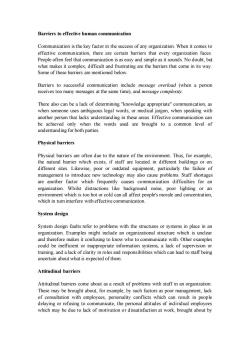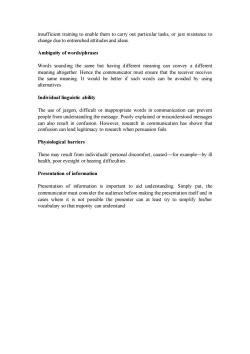《新编大学英语》综合教程(第三版第一册)B1U3_self-market_Reading Material_barriers to effective human Communication

Barriers to effective human communication Communication is the key factor in the success of any organization.When it comes to effective communication,there are certain barriers that every organization faces. People often feel that communication is as easy and simple as it sounds.No doubt,but what makes it complex,difficult and frustrating are the barriers that come in its way. Some of these barriers are mentioned below. Barriers to successful communication include message overload (when a person receives too many messages at the same time),and message complexity. There also can be a lack of determining "knowledge appropriate"communication,as when someone uses ambiguous legal words,or medical jargon,when speaking with another person that lacks understanding in these areas.Effective communication can be achieved only when the words used are brought to a common level of understand ing for both parties. Physical barriers Physical barriers are often due to the nature of the environment.Thus,for example, the natural barrier which exists,if staff are located in different buildings or on different sites.Likewise,poor or outdated equipment,particularly the failure of management to introduce new technology may also cause problems.Staff shortages are another factor which frequently causes communication difficulties for an organization.Whilst distractions like background noise,poor lighting or an environment which is too hot or cold can all affect people's morale and concentration, which in turn interfere with effective communication. System design System design faults refer to problems with the structures or systems in place in an organization.Examples might include an organizational structure which is unclear and therefore makes it confusing to know who to communicate with.Other examples could be inefficient or inappropriate information systems,a lack of supervision or training,and a lack of clarity in roles and responsibilities which can lead to staff being uncertain about what is expected of them. Attitudinal barriers Attitudinal barriers come about as a result of problems with staff in an organization. These may be brought about,for example,by such factors as poor management,lack of consultation with employees,personality conflicts which can result in people delaying or refusing to communicate,the personal attitudes of individual employees which may be due to lack of motivation or dissatisfaction at work,brought about by
Barriers to effective human communication Communication is the key factor in the success of any organization. When it comes to effective communication, there are certain barriers that every organization faces. People often feel that communication is as easy and simple as it sounds. No doubt, but what makes it complex, difficult and frustrating are the barriers that come in its way. Some of these barriers are mentioned below. Barriers to successful communication include message overload (when a person receives too many messages at the same time), and message complexity. There also can be a lack of determining "knowledge appropriate" communication, as when someone uses ambiguous legal words, or medical jargon, when speaking with another person that lacks understanding in these areas. Effective communication can be achieved only when the words used are brought to a common level of understanding for both parties. Physical barriers Physical barriers are often due to the nature of the environment. Thus, for example, the natural barrier which exists, if staff are located in different buildings or on different sites. Likewise, poor or outdated equipment, particularly the failure of management to introduce new technology may also cause problems. Staff shortages are another factor which frequently causes communication difficulties for an organization. Whilst distractions like background noise, poor lighting or an environment which is too hot or cold can all affect people's morale and concentration, which in turn interfere with effective communication. System design System design faults refer to problems with the structures or systems in place in an organization. Examples might include an organizational structure which is unclear and therefore makes it confusing to know who to communicate with. Other examples could be inefficient or inappropriate information systems, a lack of supervision or training, and a lack of clarity in roles and responsibilities which can lead to staff being uncertain about what is expected of them. Attitudinal barriers Attitudinal barriers come about as a result of problems with staff in an organization. These may be brought about, for example, by such factors as poor management, lack of consultation with employees, personality conflicts which can result in people delaying or refusing to communicate, the personal attitudes of individual employees which may be due to lack of motivation or dissatisfaction at work, brought about by

insufficient training to enable them to carry out particular tasks,or just resistance to change due to entrenched attitudes and ideas. Ambiguity of words/phrases Words sounding the same but having different meaning can convey a different meaning altogether.Hence the communicator must ensure that the receiver receives the same meaning.It would be better if such words can be avoided by using alternatives. Individual linguistic ability The use of jargon,difficult or inappropriate words in communication can prevent people from understanding the message.Poorly explained or misunderstood messages can also result in confusion.However,research in communication has shown that confusion can lend legitimacy to research when persuasion fails. Physiological barriers These may result from individuals'personal discomfort,caused-for example-by ill health,poor eyesight or hearing difficulties. Presentation of information Presentation of information is important to aid understanding.Simply put,the communicator must consider the audience before making the presentation itself and in cases where it is not possible the presenter can at least try to simplify his/her vocabulary so that majority can understand
insufficient training to enable them to carry out particular tasks, or just resistance to change due to entrenched attitudes and ideas. Ambiguity of words/phrases Words sounding the same but having different meaning can convey a different meaning altogether. Hence the communicator must ensure that the receiver receives the same meaning. It would be better if such words can be avoided by using alternatives. Individual linguistic ability The use of jargon, difficult or inappropriate words in communication can prevent people from understanding the message. Poorly explained or misunderstood messages can also result in confusion. However, research in communication has shown that confusion can lend legitimacy to research when persuasion fails. Physiological barriers These may result from individuals' personal discomfort, caused—for example—by ill health, poor eyesight or hearing difficulties. Presentation of information Presentation of information is important to aid understanding. Simply put, the communicator must consider the audience before making the presentation itself and in cases where it is not possible the presenter can at least try to simplify his/her vocabulary so that majority can understand
按次数下载不扣除下载券;
注册用户24小时内重复下载只扣除一次;
顺序:VIP每日次数-->可用次数-->下载券;
- 《新编大学英语》综合教程(第三版第一册)B1U3_self-market_QUIZ_Written Quiz.doc
- 《新编大学英语》综合教程(第三版第一册)B1U3_self-market_QUIZ_Oral Quiz.ppt
- 《新编大学英语》综合教程(第三版第一册)B1U3_self-market_Listening Material_How to Help Your Baby Learn to Talk Try Talking to Your Baby.doc
- 《新编大学英语》综合教程(第三版第一册)B1U3_self-market_Grammar and Vocabulary.doc
- 《新编大学英语》综合教程(第三版第一册)B1U3_English body language.doc
- 《新编大学英语》综合教程(第三版第一册)B1U2_Translation & Writing.ppt
- 《新编大学英语》综合教程(第三版第一册)B1U2_self market_Writing Material_How to Write a Personal Experience.doc
- 《新编大学英语》综合教程(第三版第一册)B1U2_self market_U2B1 QUIZ_Written Quiz_written quiz.doc
- 《新编大学英语》综合教程(第三版第一册)B1U2_self market_U2B1 QUIZ_06 B2U01 Oral Quiz.ppt
- 《新编大学英语》综合教程(第三版第一册)B1U2_self market_Reading Material_课文背景材料.doc
- 《新编大学英语》综合教程(第三版第一册)B1U2_self market_Reading Material_课文翻译及课后练习答案.doc
- 《新编大学英语》综合教程(第三版第一册)B1U2_self market_Reading Material_Remember Me When I am Gone Away.doc
- 《新编大学英语》综合教程(第三版第一册)B1U2_self market_Reading Material_My Personal Experience——-A Funny Memory.doc
- 《新编大学英语》综合教程(第三版第一册)B1U2_self market_Reading Material_Memory Improvement.doc
- 《新编大学英语》综合教程(第三版第一册)B1U2_self market_Reading Material_Memento Transcripts.doc
- 《新编大学英语》综合教程(第三版第一册)B1U2_self market_Reading Material_How To Improve Memory.doc
- 《新编大学英语》综合教程(第三版第一册)B1U2_Read by critical thinking.ppt
- 《新编大学英语》综合教程(第三版第一册)B1U2_Menu.ppt
- 《新编大学英语》综合教程(第三版第一册)B1U2_Activate.ppt
- 《新编大学英语》综合教程(第三版第一册)B1U1_管鲍之交.doc
- 《新编大学英语》综合教程(第三版第一册)B1U3_self-market_Reading Material_communication famous saying.doc
- 《新编大学英语》综合教程(第三版第一册)B1U3_self-market_Reading Material_How Do I Get Him or Her To Talk To Me.doc
- 《新编大学英语》综合教程(第三版第一册)B1U3_self-market_Reading Material_Unit 3活动.doc
- 《新编大学英语》综合教程(第三版第一册)B1U3_self-market_Reading Material_unit 3活动directions.doc
- 《新编大学英语》综合教程(第三版第一册)B1U3_self-market_Reading Material_第三单元 课文翻译及课后练习答案.doc
- 《新编大学英语》综合教程(第三版第一册)B1U3_self-market_Reading Material_第三单元课文背景材料.doc
- 《新编大学英语》综合教程(第三版第一册)B1U3_self-market_Samples.doc
- 《新编大学英语》综合教程(第三版第一册)B1U3_self-market_Writing Material_How to Get Rid Of Nervousness.doc
- 《新编大学英语》综合教程(第三版第一册)B1U3_self-market_Writing Material_How to Give Advice.doc
- 《新编大学英语》综合教程(第三版第一册)B1U3_U3 Activate.ppt
- 《新编大学英语》综合教程(第三版第一册)B1U3_U3 Menu.ppt
- 《新编大学英语》综合教程(第三版第一册)B1U3_U3 Read by critical thinking.ppt
- 《新编大学英语》综合教程(第三版第一册)B1U3_U3 Translation & Writing.ppt
- 《新编大学英语》综合教程(第三版第一册)B1U4_Activate.ppt
- 《新编大学英语》综合教程(第三版第一册)B1U4_Do it or not, never say I will try.doc
- 《新编大学英语》综合教程(第三版第一册)B1U4_Menu.ppt
- 《新编大学英语》综合教程(第三版第一册)B1U4_Read by critical thinking.ppt
- 《新编大学英语》综合教程(第三版第一册)B1U4_self-market_B1U04 QUIZ_B1U04 Oral Quiz.ppt
- 《新编大学英语》综合教程(第三版第一册)B1U4_self-market_B1U04 QUIZ_B1U04 Written Quiz.doc
- 《新编大学英语》综合教程(第三版第一册)B1U4_self-market_Grammar and Vocabulary.doc
